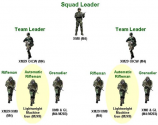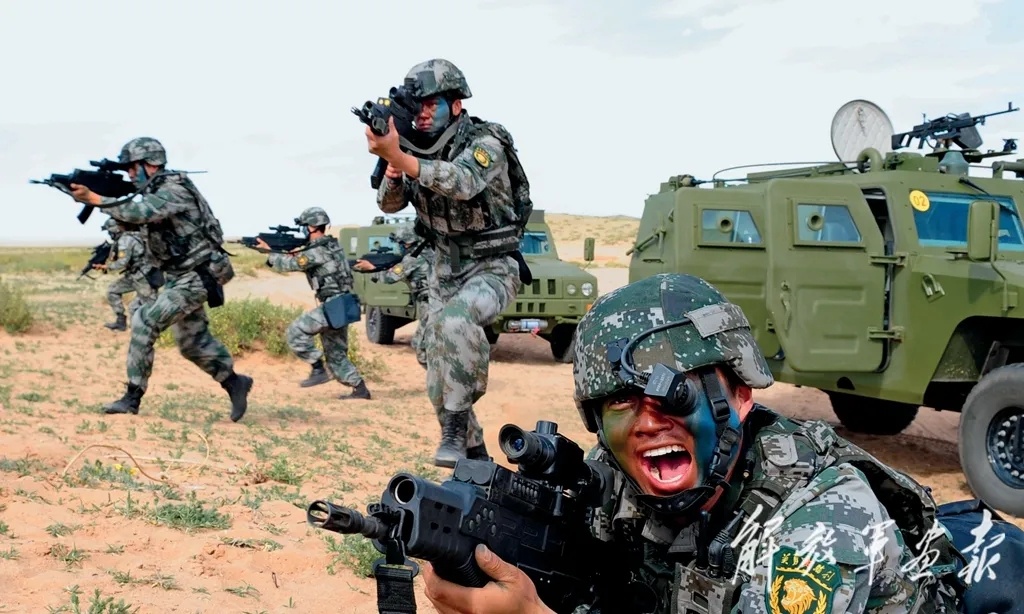What the OICW is actually transitioning to is a grenade launcher with an assault rifle option as a sidearm.
The 20mm grenade is actually fairly advantageous as a set-up, even if it's hard-pressed for firing / killing power (25-30mm might be better). The reason being, the big limitation of grenades compared to automatic / assault rifles is that grenade ammunition is heavy and dangerous to handle, with the explosive turning the combatant into a walking bomb. With 20mm grenades, you can get explosive power while not carrying too much explosive, as well as enough ammunition so that the 20mm is now a "shoot first, ask questions later" weapon as with the 5.8mm assault rifle; i.e, the small OICW grenade is now a form of suppressive fire.
And with logistics, AGLs are superior to machine guns in terms of burst killing capability, as well as offensive capability, but the amount of ammunition and logistics they go through is prohibitive. You can't replace machine guns with AGLs for that reason; AGLs run out of ammunition too fast so they can only be used in the offensive, not the defensive role.
===
The big missing part of the QTS-11, besides its unusually small caliber (like I said, 25-30mm works better), is a thermobaric round. It's coincidentally what the Russians are missing in Ukraine; the Americans apparently used thermobaric grenades to exceptional effect in Afghanistan, so it's surprising that neither the Chinese nor Russians have main-lined thermobaric grenades.
===
Wow, I've lost my ability to modify. So I'll doublepost / auto-append.
This is also one of the advantages of the QTS-11 as a semi-automatic OICW as compared to a fully automatic OICW as with the K-11 and failed XM-29. The fact that the QTS-11 is single shot helps impose ammunition discipline on soldiers in comparison with a fully automatic weapon, for which the fully automatic mode might be overkill. Making it single shot also encourages, as with the shot shown above, the equipping of entire squads with QTS-11, which is highly beneficial in comparison to heavy-weapons-centered squads as with more conventional infantry.
A squad or platoon organized around its machine guns, grenade launchers, and so on, is dependent on its machine gunners / grenade launchers and so on for its firepower. If the crew-served weapon is knocked out, the squad / platoon is rendered useless. A QTS-11-equipped platoon, in contrast, has completely even and equal firepower among its members, and a couple of QTS-11 can match a machine-gunner in terms of lethal, long-ranged firepower. The unit can continue fighting effectively until all its members are dead, which is a substantial advantage.
Oh boy. You have a ton here that has to be parceled and Especially CORRECTED.
Your post seems to be conflating two different major weapons concepts the OICW and OCSW. You have also made a complete miss characterization of the K11 and XM29/XM25.
First the OICW none of the Grenade lanchers are Fully Automatic. All of the carbine portions are.
The XM29 was semi automatic magazine fed grenade launcher with a selective fire 5.56 p
Carbine. The XM25 same deal minus the 5.66.
K11 was a magazine fed manually operating Bolt action with a 5.56 selective fire.
The QST11 is a single shot bolt action with a 5.8mm carbine.
XM29 and XM25 As a semi automatic system, the shooter always had to pull the trigger to fire. Reset the trigger between shots.
As a Bolt action repeater the K11 always had to have the shooter manually cycle the bolt.
The advantage of the QST11 is it’s lighter in weight. The disadvantage is it’s longer to load. Ammunition management is not an advantage if anything a disadvantage.
The grenade launchers were NEVER Fully Automatic!!
I can only reason that you
@Inst have conflated the separate but related Objective Crew Served Weapons concept.exemplified in the XM307 ACSW (don’t sweat the different acronym XM29 also had a alphabet soup of them including SABR)
This was a program to basically develop a family of AGL with air burst ammunition derived from the OICW but of a higher velocity. In the long run this lead to a dead end as they instead just turret mounted automatic cannons like the M230LF with air burst ammunition.
Next I have no idea what the heck you are talking about in regards to “walking bombs” are suicide bombers in suicide vests. Military explosives are very inert. They are designed for safety. To only detonate under specific conditions. Hollywood and movies love to make it all instant boom but that’s exactly what chemist and military engineers don’t want.
OICW Why was 20mm the choice? Why did XM25 only up scale to 25mm? Lighter recoil flatter trajectory, more stored kills per load. The aim was a specialized weapon that would defeat targets in behind barriers and barricades. This is why the three OICW have large suites of electronics.
FAB rounds were on the development tables but never got fielded.
XM29 or XM25 never met the ambitious weight goals. K11 seems to have other issues that have stunted it. The weapon closet in class with the widest range of ammunition including FAB was the South African Neopup or iNkunzi which fires ammunition which is literally the same 20mm shell as a Naval CIWS but in an cut down cartridge.
XM29 failed as They had a 10 lb launcher a 2 pound FCS and a 6 lb carbine. They wanted it to weigh no more than 15 lbs they were at 18.
so they broke XM29 into two separate programs in hopes of separately trimming the fat this lead to XM8 and XM25. The problem there was that separately XM8 didn’t have a proper mission need for the Army and once loaded with conventional 5.56 NATO ammunition it still ended up weighing as much as an M4. The then only route was to try and develop light weight ammunition which Spawned LSAT but it also meant XM8 was a dead end.
The Semiautomatic fire mode was dictated by doctrine, The Army wanted the ability for rapid follow on shots. The optic was limited by technology available.
XM25 continued until HK and ATK had a falling out over the Saint Petersburg declaration. An agreement that was signed by some of the forerunner states of what would become Germany, France, England, Russia just about all of Europe but not the US, ROK or Imperial China, Japan as we weren’t considered “great powers” prohibiting explosive ammunition below 400 grams.
K11 got down below 14lbs but had reliability issues and high recoil.
OST 11 is stated as less than 12 lbs. but it doesn’t seem like it fits with the emergence of QBZ191. Farther the two sights we see with the system raises questions on the ability to shift from day to night.
Blah blah again The fundamental mistake of how the systems operate leading to a massive misunderstanding of the doctrine. OICW doesn’t replace the “Machine gun doctrine”. The XM29 would have been employed like this.

mixing with not replacing.
the QST11 if anything is even more reliant on its “Machine gun” the 5.8mm portion. The explosive punch of the OICW means that the weapon has a limitation on how close it can be employed to the squad. Safety demands that you have such. OICW were conceptualized around Urban warfare which is mixed range and open and enclosed. This mix means enemies could be as near as a punch as far as a mile. To accommodate this the OICW wanted to mix a carbine for close quarters and a launcher for longer area or counter barrier. This notion of equal firepower is bogus. As General Patton put it “No bastard ever won a war by dying for his country. He won it by making the other poor dumb bastard die for his country”
Automatic fire creates a situation where in the Opposition cannot maneuver. Due to the mass of fire.
Precision fire whether artillery or rifles is then employed to remove his ability to resist.
A fortified position reduces the effectiveness of weapons organic to the platoon and artillery. It weakens the offensive force and makes them limited in Maneuver. A WW1 trench fight. To counter this often would require extreme means with high volumes of infantry at extreme risk or artillery at extreme expenditure of shells and volumes of fire. Both with questionable results.
OICW was supposed to break that by giving the offensive squad a precision weapon that can reach into that fortification and render it superfluous without having to level a building.
it’s not about fighting till the last man. That’s not What you want in a doctrine. It was about having an overwhelming advantage.



